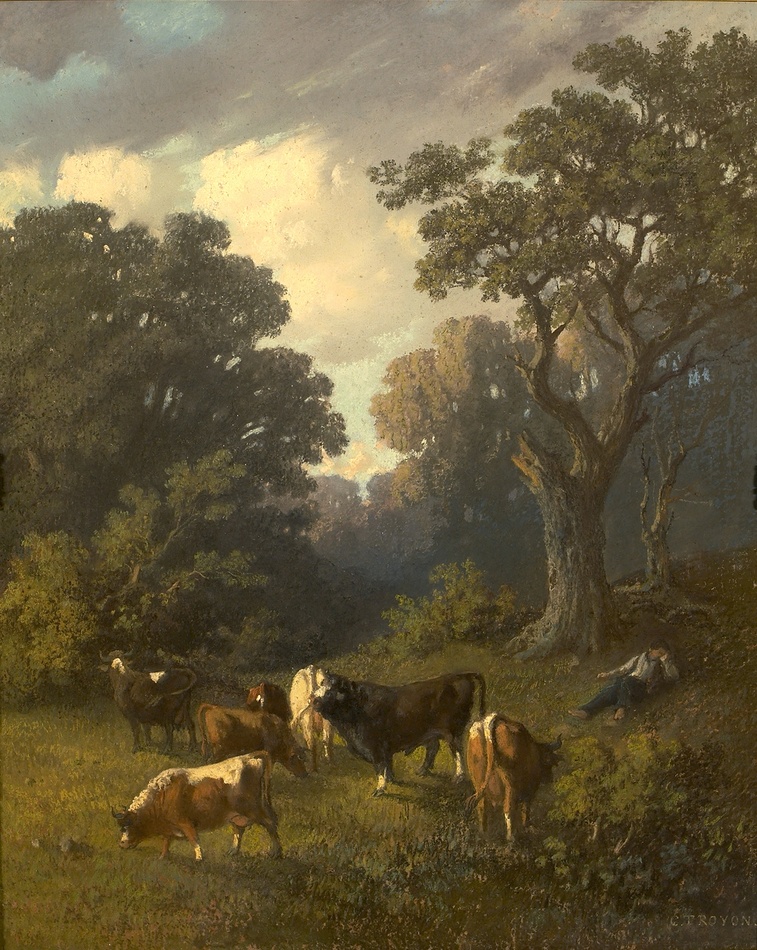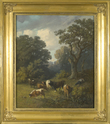Vaches paissant dans la Clairière
Signed lower right: C. Troyon.
Provenance:
Collection of the Vicomte de Curel, Paris
Sale of the above, Galerie Georges Petit, Paris, 25 Nov 1918 (orig. sale date 3 May 1918, postponed), lot 23 as 82 x 68 cm.
cf: A similarly composed pastel by Troyon entitled Rural Amenities and dated c. 1835-45 in the collection of the Heckscher Museum of Art, Huntington NY.
This work is accompanied by a certificate of authenticity from Michel Schulman and will be included in the catalogue raissoné currently in preparation.
Constant Troyon is best known for his large-scale paintings of animals inspired by the works of the two great 17th century animal painters, Albert Cuyp and Paulus Potter. Still early in his career, as Troyon developed from his initial training as a porcelain painter to pursue a more serious artistic path, he looked to another artistic source: the pastoral landscapes of the 18th-century. Works by artists such as Boucher or Pater, with their fête champetre scenes and view of an idyllic rural life would have been deeply familiar to Troyon, especially given his background in porcelain painting which drew heavily on 18th-century motifs. Indeed, Troyon even copied Boucher directly in developing his approach to the pastel medium: he completed a pendant pair of pastoral landscapes after Boucher in pastel (vente Bleymuller, 1877). Although the Barbizon painters are best known for initiating the tradition of plein air painting directly from the landscape motif, they nonetheless drew upon familiar imagery to develop their own mode of working. Troyon’s fellow artists Jules Dupré and Narcisse Virgil Diaz de la Pena, also trained in porcelain painting, similarly drew upon the Rococo style, as can be seen in Diaz’s gypsy groups or classical gods in the forest and the lush, fullness of Dupré’s pastoral mode.
The present work is a rare example of Troyon’s Rococo-influenced landscapes. The soft palette of pinks, green-blues and greens, chiaroscuro effects, and the soft forms of his trees recall the work of the great 18th-century artists, Boucher in particular. Troyon’s handling of the pastel is adept, and he must have particularly confident about his use of the medium considering the scale of the work: most pastels by the artist are significantly smaller.
Constant Troyon was born August 28, 1810 in Sevres, where both of his parents were employed in The Sevres Porcelain Factory. He was trained by Riocreux, who was in charge of the porcelain museum at the Factory, and worked as a painter on porcelain. He drew and painted from nature in his spare time. In about 1824 he met Diaz, who became a closed friend. He made his debut at the Salon with three conventional landscapes and continued to work as a porcelain decorator. He painted in Sologne, in Brittany and with Jules Dupré in 1843, in the Landes. In the same year he met Rousseau and went to work in Barbizon, where he received his true introduction to landscape painting. Troyon exhibited views of the Forest of Fontainebleau at the Salons of 1844, 1846,and 1848. The decisive moment of his career came in 1847 during a visit to Holland, when he saw the work of Cuyp and Potter for the first time. He began to introduce domestic animals into his own pictures and became as a result a famous animal painter. He continued to paint landscapes, working mainly in Normandy, and the area of Tours, also visiting England and Tours and returning occasionally to the Barbizon region. In 1859 he advised the young Monet to work out of doors. He gained an international reputation via many exhibitions of his work, which were held in collections abroad, and he was swamped with commissions. In his last years he painted seascapes on the Normandy coast; it was during this period that Boudin worked for him. Constant Troyon died March 20, 1865 in Paris at the age of fifty-five.
Reprinted from The Barbizon School and 19th Century French Landscape Painting.
Selected Museum Collections:
Paris, Musée d?Orsay, Musée du Louvre; New York, Metropolitan Museum of Art, Frick Collection, Brooklyn Museum; Boston, Museum of Fine Arts; Buenos Aires, Museo Nacional de Bellas Artes; Cambridge, Harvard University Art Museums; Art Institute of Chicago; Detroit Institute of Arts; Los Angeles County Museum of Art; Pasadena, CA, Norton Simon Museum; Philadelphia Museum of Art; Pittsburgh, Carngie Museum of Art; Fine Arts Muesums of San Francisco; Hermitage Museum, Saint Petersburg; Taiwan, Chi-Mei Museum;Washington DC, National Gallery of Art; Williamstown, MA, Clark Art Museum
Request more information
News on the artist
-
The Clark has an exhibition of British & French landscapes, including #Barbizon painters #Rousseau, #Dupré, and #Troyon. http://t.co/JEEym3mJuly 27, 2011 @ 2:40 PM UTC
-
Now in Glasgow: #Millet #Barbizon Pastel of "The Angelus" Allocated to Kelvingrove Art Gallery and Museum: http://t.co/soF2LMA via @AddThisAugust 1, 2011 @ 3:35 PM UTC
-
See the great-grandfather of French landscape painting @AshmoleanMuseum: http://t.co/3KFFPXqu #Barbizon #exhibitionsOctober 6, 2011 @ 3:00 PM UTC
-
National Gallery of Art to reopen 19th-century French galleries in January: http://t.co/2HcCfSuF #Academic #PostImpressionist #BarbizonOctober 20, 2011 @ 9:17 PM UTC
-
Masterpieces from the Musée d'Orsay on view in Asia: http://t.co/xNhXdBgT #Realism #Barbizon #Academic #Impressionism #exhibitionsNovember 1, 2011 @ 3:38 PM UTC
-
Take a photo tour of @MuseeOrsay new Impressionist galleries: http://t.co/gmVlnx5n @artinfodotcom #Academic #Impressionism #BarbizonNovember 3, 2011 @ 4:34 PM UTC
-
Städel Museum to open Claude #Lorraine exhibition in February 2012: http://t.co/rA5Z1eTr via @AddThis #exhibitionsIwishIcouldsee #BarbizonDecember 12, 2011 @ 10:53 PM UTC
-
When you visit the new 19th-century galleries @ngadc don't miss this #Rousseau http://t.co/Qgr6EWp5 and http://t.co/awPyBEDl #BarbizonJanuary 30, 2012 @ 10:42 PM UTC
-
http://t.co/xkAzAOwi - Would #Renoir be the same had he not met #DiazdelaPena in #Barbizon in 1862 and come under his influence?February 7, 2012 @ 10:14 PM UTC
-
March 16, 2012 @ 7:56 PM UTC
-
Google expands Art Project to 150+ #museums http://t.co/SFjJl9UI Here is an early #Corot @philamuseum http://t.co/M6AuUwof #BarbizonApril 10, 2012 @ 2:50 PM UTC
-
Paradises & Landscapes in the Thyssen Coll. opens in Málaga: http://t.co/bS54sQ4n #Barbizon #PostImpressionist #Impressionism #exhibitionsApril 10, 2012 @ 3:09 PM UTC
-
April 13, 2012 @ 9:22 PM UTC
-
Happy Birthday Jules #Dupre April 15, 1811 (same day as Theordore #Rousseau!) http://t.co/Vq4MBTrD #BarbizonApril 13, 2012 @ 9:23 PM UTC
-
Baroness Carmen Thyssen Bornemisza to sell "The Lock" by John #Constable at Christie's: http://t.co/qdMksw47 #Academic #BarbizonMay 30, 2012 @ 7:40 PM UTC
-
Shame that this is leaving the @museothyssen - Protest in Spain at sale of #Constable 's 'The Lock' http://t.co/xFY0yAKn #museums #BarbizonJuly 2, 2012 @ 4:03 PM UTC
-
July 16, 2012 @ 8:01 PM UTC
-
August 29, 2012 @ 10:26 PM UTC
-
#Courbet 's Majestic Oak Painting Returns to Its Roots After Hometown Museum's $5-Million Purchase http://t.co/y2JTiZXo #Barbizon #RealismSeptember 7, 2012 @ 3:07 PM UTC
-
Musee d'Orsay opens major show of 19th-cty paintings at new Shanghai museum http://t.co/DE9KXjtE #Barbizon #Naturalism #CourbetNovember 19, 2012 @ 10:19 PM UTC
-
French #Romantic, #Realist, #Barbizon and #Impressionist drawings on view at National Gallery of Art, Washington http://t.co/lxq8IPwUJanuary 28, 2013 @ 11:44 PM UTC
-
February 14, 2013 @ 4:00 PM UTC
-
#Courbet 's Modernity - lecture by Jack Flam at the NY Studio School tomorrow! http://t.co/OPWboSvmWK #Barbizon #RealismMarch 12, 2013 @ 3:27 PM UTC
-
Jacquemart-André Museum in Paris opens exhibition devoted to Eugène #Boudin http://t.co/FUAqaF7MGn #Barbizon #exhibitionsIwishIcouldseeMarch 21, 2013 @ 2:55 PM UTC
-
Tim Marlow on TEFAF's Treasures on Sotheby's Blog includes #Constable #Delacroix #Gericault http://t.co/Z82FXz1Lul #Barbizon #RomanticismMarch 22, 2013 @ 9:14 PM UTC
-
Happy belated bday Theodore #Rousseau http://t.co/7UrhiBahm6 and Jules #Dupre http://t.co/ATFe97j3cs. Apr 15 -a great day for #Barbizon artApril 16, 2013 @ 4:05 PM UTC
-
June 10, 2013 @ 3:41 PM UTC
-
Now at Schiller & Bodo : MASTERWORKS OF THE BARBIZON SCHOOL, on view through November 27 http://t.co/pgDhaUAscc #Barbizon #exhibitionsNovember 5, 2013 @ 4:10 PM UTC
-
April 15, 2014 @ 5:33 PM UTC
-
And Happy Birthday Jules #Dupre - April 15, 1811 - a great day for #Barbizon School painters! http://t.co/62PKvhJpN8April 15, 2014 @ 7:03 PM UTC
-
Take a look at this #Diaz from the 1904 #WorldsFair at the @kemperartmuseum in St. Louis. http://t.co/n2h0vSI9Fw #BarbizonMay 1, 2014 @ 3:35 PM UTC
-
Here is our current #exhibition catalogue: A Romantic Vision, The #Barbizon School and its Contemporaries http://t.co/iemkJ4fmdGMay 5, 2015 @ 5:16 PM UTC
-
300 years of French landscape painting at the Toledo Museum of Art, including #Rousseau #Courbet #Daubigny http://t.co/j21mPIWRc4 #BarbizonAugust 11, 2015 @ 2:52 PM UTC
-
#Daubigny, Monet, Van Gogh: Impressions of Landscape is open now at the Taft Museum of Art- https://t.co/8BlaBpUD0P #Barbizon #ImpressionismMarch 10, 2016 @ 5:50 PM UTC
-
Rediscovering #Daubigny , an Unsung Influence on the Impressionists https://t.co/nPa7zTFG4d #Impressionism #BarbizonMarch 15, 2016 @ 3:01 PM UTC
-
Happy Birthday Théodore #Rousseau , born April 15, 1812 : https://t.co/lJZexdfYUU #Barbizon #artistbirthdaysApril 15, 2016 @ 7:09 PM UTC
-
Opening Monday- Unruly Nature: The Landscapes of Théodore #Rousseau @ the Getty https://t.co/L9tATSW4sX #Barbizon #exhibitionsIwishIcouldseeJune 17, 2016 @ 8:23 PM UTC
-
Théodore #Rousseau Gets His Due at the Getty Museum https://t.co/MLe45ku6oS #Barbizon #exhibitionsIwishiIcouldseeJuly 15, 2016 @ 7:30 PM UTC
-
Opening at the @vangoghmuseum : #VanGogh #Rousseau #Corot: In the Forest : https://t.co/NSNvTW3bV5 #Barbizon #exhibitionsIwhiIcouldseeJuly 13, 2017 @ 9:49 PM UTC
-
Happy Birthday to Jean Francois #Millet, one of the original great #Barbizon painters, whose work has moved its aud… https://t.co/w7kqh3CTZZOctober 4, 2018 @ 5:43 PM UTC




